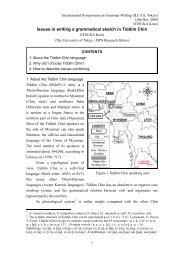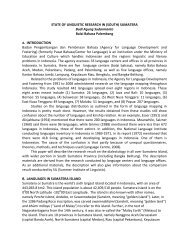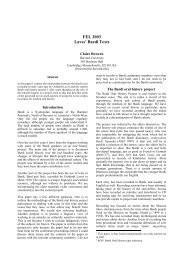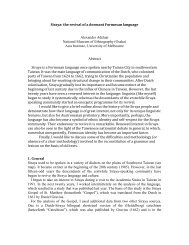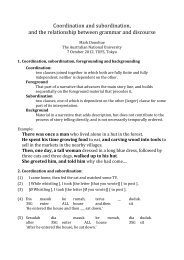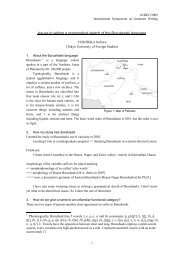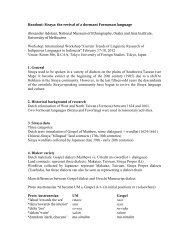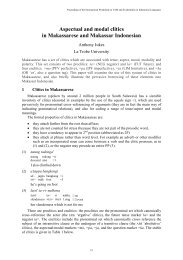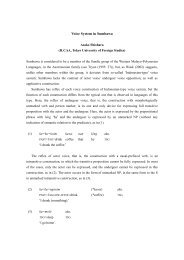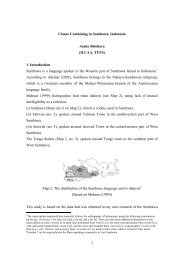Abstract
Abstract
Abstract
Create successful ePaper yourself
Turn your PDF publications into a flip-book with our unique Google optimized e-Paper software.
Kalimantan languages:An overview of current research and documentationAntonia Soriente(University of Naples ‘L’Orientale’ andMax Planck Institute for Evolutionary Anthropology)Kazuya Inagaki(JSPS Research Fellow (Kyoto University))<strong>Abstract</strong>This presentation provides an overview of the language situation in Kalimantan, Indonesia,and a report on studies of the languages in the region. We will list language/dialect names inKalimantan and show maps of the languages in four geographical areas, namely, Northwest(Land Dayak and Tamanic), Northeast (Kayanic, Kelabitic, Kenyahic, Punan, and Sama-Bajau),Southern inland (Barito), and the surrounding area (Malayic), and will give detailed informationon language documentation projects mainly in the Kenyah and Punan languages of EastKalimantan and in the Barito languages of Central Kalimantan.In the northeast part of Kalimantan are recorded many language groups, including theKenyah that have a high level of differentiation and the Punan, a loose category that groupslanguages that are unintelligible with each other. Unfortunately many of the languages of thearea lack descriptions and availability of data.If we exclude the Stokhof wordlists (1986) whose material dates back to the beginning ofthe twentieth century, and overlook the language projects carried out in the whole part ofBorneo, mainly in Sarawak and Sabah, no serious documentation work has been undertaken onthe Kalimantan languages till the early 2000 when Soriente started a comparative description ofthe Kenyah languages (Soriente 2004 and 2008) and a documentation project on two Kenyahlanguages, mainly Lebu’ Kulit and Òma Lóngh. This resulted in a book containing a collectionof stories in the two languages followed by a glossary (Soriente 2006) and several descriptionsof different aspects of the languages (Soriente 2011, a,b,c, and to appear, b). Based on Soriente2006’s book, Blust (2007) published an historical phonology of the Òma Lóngh language.While the project on Kenyah has been carried out, a new interest on Punan and Penan languageshas developed and this has led to a new project that aims at documenting a Western Penanlanguage spoken in Kalimantan, Penan Benalui (Soriente to appear, a), Punan Tubu’ (Sorienteto appear, b and c), and Punan Malinau. These three languages are very different but their studyis relevant because this can shed light to the unresolved problem of the classification of Punanlanguages in particular (see Sellato 1993 and forthcoming) and of the possible Austro-Asiaticorigin in Borneo (see Blench 2010, Adelaar 1995). Punan Tubu’ folktales have become theobject of another documentation project that will produce a book of stories and a dictionary(Soriente to appear, c) while the Punan Malinau is being studied due to its peculiar phonologicalstructure.As far as Kayan and Kayanic languages are concerned, if very little has been produced afterthe Holle list (Stokhof 1986) and an epic of high relevance in the Kayan world, Takna Lawe’,not much is available on Kayan languages spoken in Kalimantan. Guerreiro (1986, 2009 and toappear) has been involved in the study of Kayanic Busang, Modang and Wehea and is at themoment concentrating on the study of Basap and other languages of the Sajau group.1
HUDSON, ALFRED B. 1967. The Barito isolects of Borneo: A classification based oncomparative reconstruction and lexicostatistics. Ithaca, New York: Department of AsianStudies, Cornell University.—. 1978. Linguistic relations among Borneo peoples with special reference to Sarawak:An interim report. In Sarawak Linguistics and Development Problems, number 3 in Studiesin Third World Societies, 1–43. Williamsburg, Virginia: Department of Anthropology,College of William and Mary.INAGAKI, KAZUYA. 2005. Phonemic sketch of Dohoi/Kadorih. Kyoto University LinguisticResearch 24. 15–43.—. 2006. A sketch on the morphosyntax of Kadorih (Dohoi: Austronesian). KyotoUniversity Linguistic Research 25. 41–65.—. 2007. Word medial stops and affricates in Kadorih [in Japanese]. Gengo Kenkyu 132.111–121.—. 2008. Kadorih: Description of an Austronesian language of Borneo. Ph.D. thesis,Kyoto University.SELLATO, BERNARD. 1993. The Punan question and the reconstruction of Borneo’s culturehistory. In Change and Development in Borneo, ed. by V. H. Sutlive Vincent H. Jr., 47–82.Williamsburg, VA: Borneo Research Council.—. forthcoming. The Languages and peoples of the Müller Mountains and the origins ofBorneo’s nomads and their languages. In Proceedings of the Conference ‘Languages andLiteratures of Western Borneo. 144 Years of Research’. ATMA IKON UniversityKebangsaan Malaysia, 31 January 2 February, 2005.SORIENTE, ANTONIA. 2004. A classification of Kenyah varieties in Sarawak and Kalimantan.Ph.D. thesis, Universiti Kebangsaan Malaysia.—. (ed.) 2006. Mencalèny & Usung Bayung Marang. A collection of Kenyah stories inthe Òma Lóngh and Lebu’ Kulit languages. Jakarta: Atma Jaya University Press.—. 2008. The classification of Kenyah languages: A preliminary statement. InProceedings of South East Asia Linguistic Society (SEALS) 14.—. 2009. Reconstructing kinship terminologies in the languages of the hunter-gatherersof Borneo. Presented at the 19th International Conference on Historical Linguistics (ICHL),Kinship Terminologies: Change and Reconstruction. Nijmegen.—. 2010. Punan and Penan. Are they related? Presented at SEALS XX South-East AsiaLinguistic Society. University of Zurich.—. 2011a. Variation in aspect and modality in Borneo. Presented at Workshop onTAME in Indonesian Languages. Research Institute for Languages and Cultures of Asiaand Africa, Tokyo University of Foreign Studies.—. 2011b. Deixis in Kenyah and Punan languages of Borneo. Presented at Workshop onDeixis and Spatial Expressions in Indonesian Languages. Research Institute for Languagesand Cultures of Asia and Africa, Tokyo University of Foreign Studies.—. 2011c. Documentation of oral traditions in the Kenyah and Punan communities ofBorneo. Presented at Songs of Memory. Safeguarding Cultural Heritage at the Turn of the21st Century Ateneo de Manila.—. to appear, (a) Hunter gatherers in Borneo and the case study of the Penan Benalui. InHunter-gatherers and Linguistic History: A Global Perspective. ed. by Tom Güldemann,Patrick McConvell and Richard Rhodes. Cambridge: Cambridge University Press.—. to appear, (b) Undergoer Voice in Borneo. Penan, Punan, Kenyah and Kayanlanguages. Asian and African Languages and Linguistics, 5.—. to appear, (c) (with Dollop Mamung, Nicolas Cesard & Antonio Guerreiro). Unjungdan cerita lain. (Cerita Punan Tubu’ dengan kamus dan tata bahasa dasar). Jakarta: EFEOand Gramedia.3
STOKHOF, W. A. L. (ed.) 1986. Holle lists: Vocabularies in languages of Indonesia Vol. 8,Kalimantan (Borneo). Canberra: Department of Linguistics, Research School of PacificStudies, Australian National University.Tjia, Johnny. 2007. A grammar of Mualang: An Ibanic language of Western Kalimantan,Indonesia. Utrecht: LOT.4



